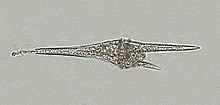囊泡虫
来自维基百科,自由的百科全书
囊泡虫总门(学名:Alveolata)[2]是一大类原生生物.
门
囊泡虫类可分为4个门, 在形态上具有非常大的多样性,但根据细胞内的超微结构与基因具有密切亲缘关系:
- 顶复门(Apicomplexa) - 营寄生的原生生物,缺少轴丝运动结构,但是配子例外;
- 色虫门(Chromerida) - 一种具有光合自养的海生原生动物,是顶复门与藻类的进化过渡的中间物种;
- 纤毛虫门(Ciliate) - 非常常见的原生动物,具有成排的纤毛
- 双鞭毛虫门(Dinoflagellate) - 大都是海生鞭毛虫,往往有叶绿体
帕金虫属(Perkinsus)可能属于另一个进化分枝 - 帕金虫门(Perkinsozoa) - 基于许多分子生物学证据.[3]
特征
囊泡虫最著名的公共特征是存在皮层内生膜囊(cortical alveoli), 扁平的囊泡折叠为连续层支撑着膜,通常形成灵活的薄皮。双鞭毛虫通常形成硬壳。 囊泡虫具有带管状嵴的线粒体。鞭毛或纤毛有不同结构.
这类原生生物的祖先显然是营光合作用的.[4]
几乎所有的纤毛虫与顶复门寄生虫的线粒体基因组是线状的.[5]巴贝斯原虫(Babesia microti)的线粒体基因是环形的.[6]这个物种因而被认为不属于巴贝斯虫属(Babesia)或泰勒虫属(Theileria),应该为它创建一个新的属。
分类
顶复门与双鞭毛虫门具有很近的亲缘关系,被合称为粘孢子总门,而纤毛虫门则比较疏远。顶复门与双鞭毛虫门都有色素体,在细胞顶部大都有一束或圆锥形微管. 对于顶复门生物,这形成了顶复器用于进入宿主细胞。某些无色的双鞭毛虫这形成了口器用于摄入被掠食的微生物。其它囊泡虫类的生物与这两类具有不同远近的亲缘关系,大部分鞭毛虫有类似的顶器结构。这包括自由生活的Oxyrrhis与Colponema, 营寄生的Perkinsus, Parvilucifera, Rastrimonas与ellobiopsid. 2001年, 对海洋微微型浮游生物样本的rRNA研究表明,存在两个新的囊泡虫进化世系,称作group I与II.[7][8]Group I没有近缘亲属,而group II与双鞭毛虫门共甲藻目(Syndiniales)的寄生生物Amoebophrya亲缘很近.
在1980年代,提出了这几大类微生物可能属于一个进化分枝。1990年代通过基因研究证实了这一想法,特别是Gajadhar等人的研究工作.[9]汤玛斯·卡弗利尔-史密斯, 于1991年正式命名了囊泡虫总门(Alveolata),[10]在当时还认为这可能是一个并系群, 实际上后来证实是单系群.
某些研究认为最著名的海洋无脊椎动物的寄生虫haplosporid应该属于囊泡虫总目,但缺少腔区(alveoli),因此现在被分类在有孔虫界的丝足虫类.
发展
囊泡虫的色素体的发展还不确定. 卡弗利尔-史密斯建议囊泡虫的祖先是一种有叶绿体的,并发展成了色藻界 (囊泡藻界假说). 但是,色素体只出现在相对衍生的(而不是比较古老的)群体, 其它人的观点是囊泡虫最初缺少色素体,可能是双鞭毛虫与顶复门生物分别独立获取色素体。
进化
囊泡虫的共同起源可能是一种吸食(myzocytotic)被掠食者的细胞,有两条鞭毛, 微孔, 刺丝胞(trichocyst), 棒状体(Rhoptry), microneme, polar ring与一个锥形顶部开口的顶器.[12]这个祖先可能拥有色素体,但还不清楚是否具有光合作用的能力。还不清楚现存的perkinsids与colpodellids是否还有这个细胞器.
参考文献
外部链接
Wikiwand - on
Seamless Wikipedia browsing. On steroids.

